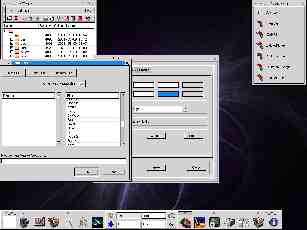|
XFce Window Manager (for *nix Systems) Review - Page II
By Guest Reviewer "Hotwire"
Warning: this review contains heavy Linux Terminology. It is recommended that only experienced Linux users continue, as it may only confuse others :)
USING XFce

One of the first things you will probably notice is that there is no taskbar, and programs which are running are indicated either by their open windows, or by their respective icons on the desktop when minimized. It is also possible to display a list of running tasks by right clicking on a clear spot on the desktop. Task switching can then be done via the simple menu that appears.
You will also notice that there are no icons used to start programs stored on the desktop (unlike in KDE or MSWindows for example). However if you wish to use shortcuts on the desktop, running KFM for example, will start the KDE File Manager which lets you do this.
These two differences might take a little getting used to, especially if you're very familiar with KDE/Windows etc, but once you're comfortable with them, it really becomes second nature.
It is possible to run KDE and Gnome apps from within XFce, allowing you to use your favourite KDE proggies without having to login under KDE!
The XFce main panel has a user-defined amount of menu items on it, and it's clearly a good idea to sort your frequently used programs into appropriate categories. For example, I have a graphics tab on it, clicking the main icon of the paint brush will run 'XV'. Clicking the little arrow pointing up will then display a menu containing more icons, (such as the Gimp, X-paint, SANE etc).
The main panel has 'tear off' menus so that if you are regularly selecting items from a particular menu, you can 'tear' it off and keep it floating on the desktop for easy access.
Like most window managers for *nix, XFce utilises multiple desktops (or 'workspaces'), which can be selected by using the XFce pager. Four desktops are the default, and I usually find this is more than adequate, although you can have up to 10 desktops! I normally have XMMS (mp3 player) running on desktop 4, with the 'Add files to playlist' window kept open and enlarged. Any internet stuff is on desktop 2, and I use 1 & 3 for general file manipulation/text editing etc. To send programs between desktops, you need to minimize the program to an icon on the desktop, and then right click on the icon and select 'Send to...>'. You can also left click on the '_' at the top lefthand corner of an open window and do the same.
Often I find that the pager module just gets in the way, and I often get sick of it and just close it, using the buttons in the middle of the main panel to switch between desktops instead.
XFce has the option of playing short sounds whenever you maximize, pop a menu up, etc, much the same as Windows. I disable this as it gets very annoying, very quickly, by stopping the sound module from loading when I start XFce. You do this by pressing the 'Setup...' button on the main panel (with the pic of the paint palette), going to the 'Startup' tab, and unticking 'Sound Module (xfsound)'.
PREV -- NEXT
| 
